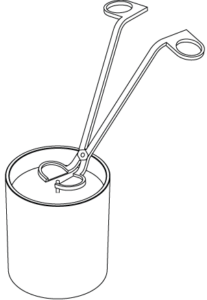If you’ve been neglecting the necessary upkeep of your scented soy candles by merely lighting and extinguishing them, you haven’t been giving yourself or your candles the attention they deserve. By incorporating a few simple practices, like regularly trimming the wicks and safeguarding the wax from dust, you can enhance the longevity and evenness of your candle’s burn. Uncover the reasons why trimming the candle wick is essential and explore six additional recommendations for maintaining the well-being of your candles.
Why You Should Trim the Candle Wick

It may seem insignificant, but the act of trimming a candle wick can actually have a significant impact on your candle experience. You might think that whether you trim the wick or not, your candle will still burn, right? Technically, that’s true. However, taking the small step of trimming the wick can extend the lifespan of your candle by up to 25 percent and maintain its aesthetic appeal.
Allowing a wick to remain long results in a larger flame, which causes more wax to melt and provides the candle with excess fuel. This surplus fuel can lead to incomplete combustion, resulting in increased soot production that leaves your candle container black and dirty. Moreover, long wicks often develop a curl on top as they burn, creating an uneven shape that further contributes to soot buildup.
Maintaining a well-trimmed candle wick plays a crucial role in managing the amount of melted wax, or fuel, available to the flame, thereby reducing the production of soot. A properly trimmed wick also promotes even burning, helps control soot formation, and extends the candle’s lifespan. Additionally, by minimizing soot buildup, it becomes easier to repurpose the candle jar once the candle is fully burned.
After burning a candle for approximately four hours, it is important to extinguish the flame and allow the candle to cool down to room temperature, which typically takes about two hours for larger candles. Then, before relighting, trim the wick to a length of approximately one-eighth to one-fourth inch. Initially, scissors can be used for trimming, but as the candle burns down, nail clippers or a dedicated wick trimmer may be more convenient tools to use.
Other Candle Care Tips
In addition to wick trimming, there are several other practices you can incorporate into your candle care routine to enhance its longevity and preserve its pristine appearance. By following these six tips, you can ensure that your soy or coconut wax candle remains in excellent condition just like the day you first purchased it:
- Ensure that the candle burns for approximately two hours during its initial use to allow the entire top layer of wax to liquefy and solidify evenly. Insufficient burning time may result in tunneling, where only the center of the candle melts while leaving a ring of unburned wax around the edges.
- Avoid burning the candle for more than four consecutive hours. Beyond this point, the wax can become excessively hot, compromising the fragrance of the candle and causing smoke, which can mar the appearance of the container and affect the scent.
- If you notice the wick shifting or bending while the candle is burning, extinguish the flame and allow the candle to cool. Then, use your fingers, tweezers, or tongs to reposition the wick back to the center and straighten it. Trimming the wick regularly to a shorter length will also help prevent it from drooping or moving out of place.
- Avoid placing the candle in an area with drafts. Air currents can disrupt the flame, causing uneven burning or even extinguishing it completely. Keep the candle away from vents, fans, open windows, air conditioning units, or any other sources of air movement that may expose the flame.
- Maintain a clean and dust-free surface on top of your candle. If you don’t burn the candle frequently (although we can’t imagine why not!), dust and particles can accumulate on the surface. Store the candle in a covered cabinet or use the lid (if available) to prevent dust buildup. If you do notice dust on the wax, gently wipe it off with a damp cotton pad before relighting.
- Prevent the accumulation of soot marks on the glass, as they can become difficult to clean over time. Apply a small amount of soap to a damp cotton pad and gently wipe away the soot stains. Ensure the glass is completely dry before relighting the candle.

